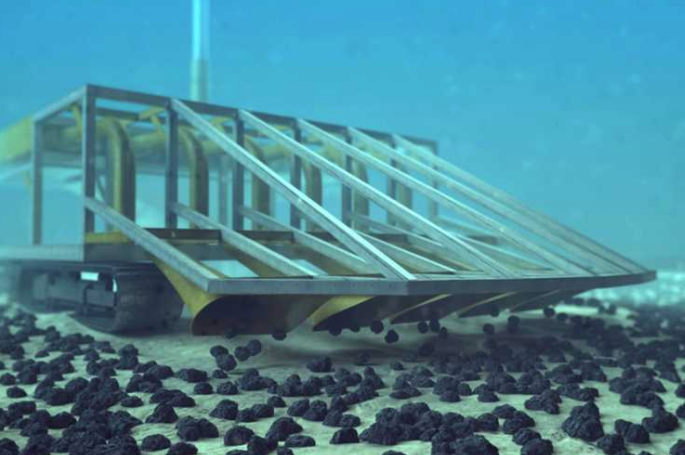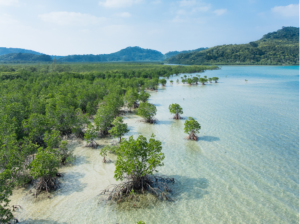
Celine E.J. van Bijsterveldt, Bregje K. van Wesenbeeck, Sri Ramadhani, Olivier V. Raven, Fleur E. van Gool, Rudhi Pribadi, Tjeerd J. Bouma, Does plastic waste kill mangroves? A field experiment to assess the impact of macro plastics on mangrove growth, stress response and survival, Science of The Total Environment, 2020, 143826, ISSN 0048-9697, https://doi.org/10.1016/j.scitotenv.2020.143826.
A forest unlike any other
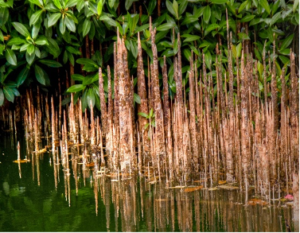
Mangroves are coastal trees [and shrubs] with particular adaptations to saltwater. Some species of mangrove create straw-like breathing-tubes that stick straight up out of the water (pictured right). Others have holes in their bark to breath from. Some excrete salt directly, while others concentrate it in old leaves that are later shed. The complex roots systems form a web-like habitat full of resources and protection for intertidal species, making them highly important to the ecosystems in which they reside. Unfortunately, these webs are also great at capturing human refuse.
Mangroves are found primarily in tropical regions, spanning approximately 25ºN – 25ºS. Mangrove forests strengthen the soil, creating protection from erosion, storm surges, and even tsunamis. They also provide a valuable food source for local villages. Many mangrove regions are poor and underdeveloped, which increases both the need for and destruction of, these habitats. Mangroves forests are declining the fastest in South East Asia; a region where 1/3 of all mangroves are found. One-fifth of global mangroves are estimated to have been lost since the 1980s, most commonly due to clear-cutting for shrimp farming. Poor Asian countries often have waste management issues, with a lack of garbage collection in most rural regions. This problem is estimated to result in 5-13 million tonnes of plastic waste entering the ocean yearly. The top countries contributing to oceanic plastic waste are China, Indonesia, the Philippines, and Vietnam.
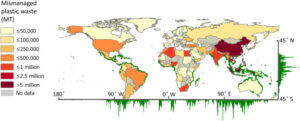
The Study
The authors set out to discover how much plastic is captured and buried in mangrove forests, as well as its impact on tree survival. They counted the number of plastic items in m2 sections of the forests and calculated the percentage of forest floor coverage. They also took sediment cores to investigate the amount of plastic being buried and how deep it went. Cores were taken by slowly rotating a saw head into the sediment to ensure plastic layers were cut and not pushed down, and sediment layers remained intact.
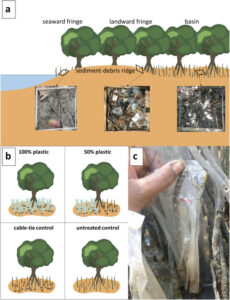
Plastic coverage experiments were also conducted with 42 seaward trees of a mature mangrove stand. The site was chosen due to its mostly disconnected presence from other mangrove stands. There were 4 treatment variables divided up amongst the 42 trees. 1) 100% of aerial tree roots were covered in plastic with it zip-tied in place; 2) 50% of roots covered; 3) no coverage, but still zip-tied, and; 4) no coverage and no zip-ties. Treatment 3 was to compare with the first 2 to account for any impact the zip ties may have had. Treatment 4 was to compare how the plastic coverage impacted the trees relative to non-covered trees.
Experiments were conducted for six weeks, and several methods of stress were assessed. Throughout the experiments, leaf litter was collected by nets under the trees and picked up weekly. Leaf area was compared before and after the investigations by drone-collected images. And root growth was assessed by both the number of new pneumatophores (breathing-tube roots) and the development of existing ones.
Results
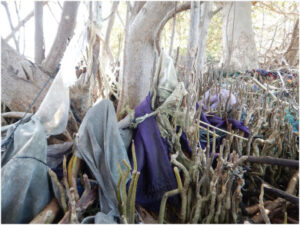
The m2 forest floor analyses found plastic in every plot. There was an average of 27 plastic items per m2 and a maximum of 236. Forest floor coverage was, on average, 17%, with many areas greater than 50%, and some up to 75%. Sediment cores found plastic to be frequently buried in several sediment layers at least as deep as 35 cm.
The experiments found significant impacts on tree growth and survival with plastic cover. While all trees had root growth, the plastic-covered trees (especially the 100% cover) had significantly more growth. The plastic-covered trees had a more significant change in new roots as opposed to existing roots. These results suggest that suffocating trees invested their energy into creating new sources of oxygen.
Both in terms of leaf cover, and overall survival, the half-covered trees were found to be surprisingly resilient to the plastic cover. The full-covered trees, however, had a significant decrease in leaf coverage and most died by the end of the experiment.
Summary
Plastic pollution is a globally pervasive problem that is threatening many plants and animal species. In tropical regions where mangroves live, they are being suffocated by plastic debris covering their root systems. Plastic was found to cover up to 75% of the forest floor and was buried over 30 cm deep. Trees that are only partially suffocated may be able to survive, but these already endangered species are facing increasing risks.
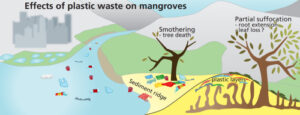
HOW TO HELP
- Recycle! Recycle! Recycle!
- Avoid buying plastic as much as possible!
- Remember your re-usable bags!
- Shop locally when possible.
I am a 2nd year Master’s student at the Memorial University of Newfoundland. I am researching the highly invasive species the European green crab, and the impact extreme weather events has on its population abundance and distribution.


